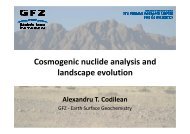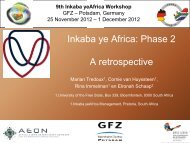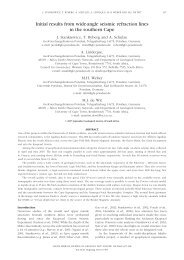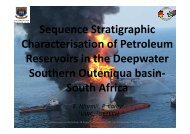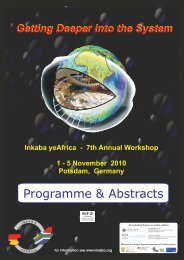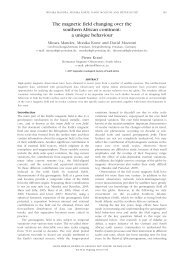South Africa - Inkaba.org
South Africa - Inkaba.org
South Africa - Inkaba.org
You also want an ePaper? Increase the reach of your titles
YUMPU automatically turns print PDFs into web optimized ePapers that Google loves.
Petrogenesis of the False Bay dyke swarm, Cape Peninsula,<br />
<strong>South</strong> <strong>Africa</strong><br />
N R Backeberg 1 , D L Reid 1 , R B Trumbull 3 , R L Romer 4<br />
1. University of Cape Town, <strong>South</strong> <strong>Africa</strong>, nils.backeberg@gmail.com<br />
2. University of Cape Town, <strong>South</strong> <strong>Africa</strong>, david.reid@uct.ac.za<br />
3. Deutsches GeoForschungsZentrum, 14473 Potsdam, Germany, bobby@gfz-potsdam.de<br />
4. Deutsches GeoForschungsZentrum, 14473 Potsdam, Germany, romer@gfz-potsdam.de<br />
ABSTRACT<br />
The False Bay dyke swarm is the southern NW-SE trending end-member of the Cretaceous dolerite dyke intrusions<br />
on the western <strong>Africa</strong>n margin, associated with rifting of Gondwana and opening of the <strong>South</strong> Atlantic Ocean. This<br />
southern dyke swarm has been associated with a low-flux, passive rifting end member compared to its northern<br />
high-flux, active rifting counterpart: the Henties Bay-Outjo dyke swarm in Namibia. The contrast in basaltic<br />
magma types and magma flux between north and south has been related to different tectonic settings (i.e. magma<br />
sources) along the current coast line during Cretaceous rifting. Further, the False Bay dyke swarm is characterised<br />
by olivine-tholeiites with quite extreme differentiation to ferro-tholeiites within a monogenetic magma system. The<br />
finer details of the differentiation process identified through trace element analysis and major element modelling<br />
are presented here. Both crystal fractionation and assimilation trends are identified for the False Bay dolerites<br />
during magma evolution. Crustal assimilation processes are only identified in samples with less than 5 wt% MgO.<br />
This observation is consistent with trace elements and Sr and Nd radiogenic isotopes, while initial differentiation<br />
(greater than 5wt% MgO) is characterised by pure fractional crystallisation. Initial variation in conserved trace<br />
element ratios, prior to assimilation, is not correlated to differentiation and is assumed as a result of variations<br />
within the enriched source rock.<br />
KEYWORDS: dolerite dykes, trace element ratios, Sr and Nd isotopes, Gondwana rifting, differentiation<br />
4



